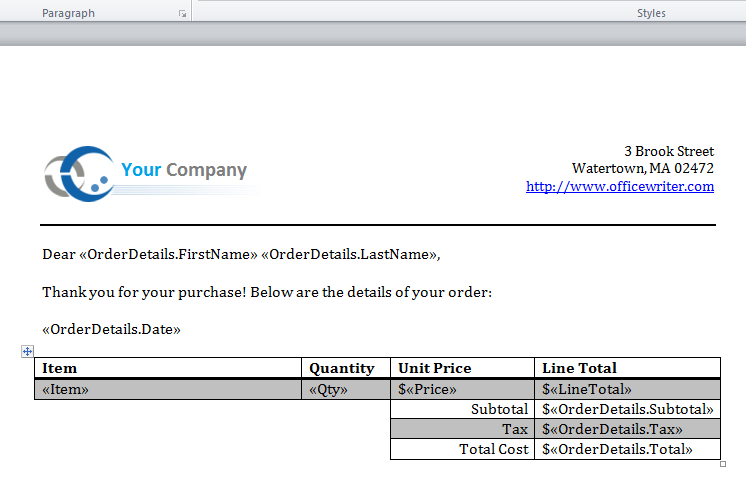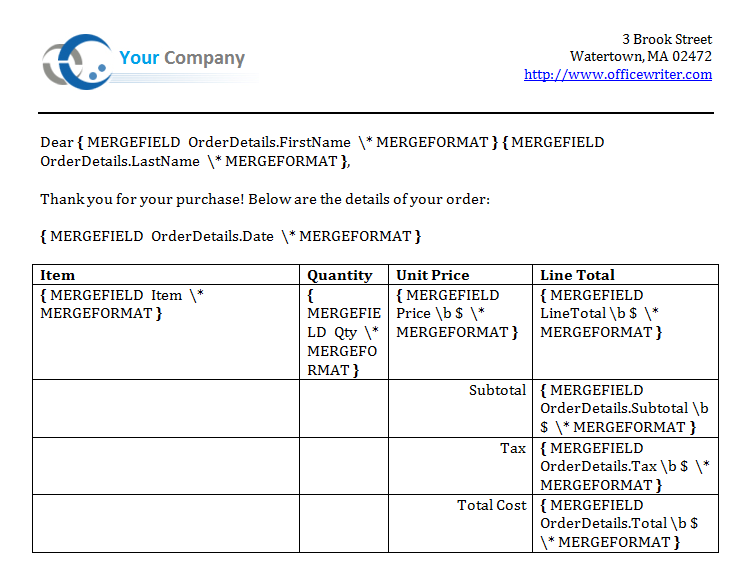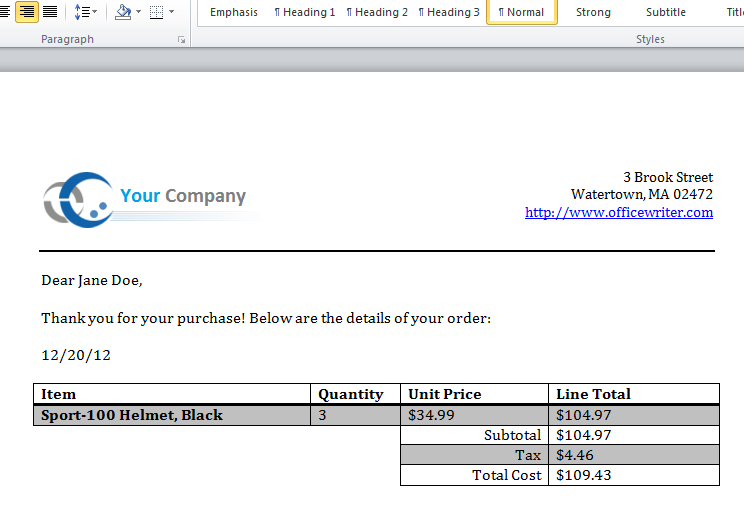Table of Contents
Table of Contents |
|---|
| |
A WordWriter template is a Microsoft Word file that contains merge fields. A merge field displays a data source field (for example, a database column name). A merge field is created in Microsoft Word and bound in code to a data source. The data source may be an array, a DataSet, a DataTable, or a DataReader. When you run the code, WordWriter populates the merge fields with data source values. A template may contain multiple sets of merge fields. Each set of fields binds to a single data source.
If you assigned a different data source separator, you can also use a "." in your data source and column names. |
|
Use brackets if your column name does not conform to these rules |
The final template will resemble this:

|
In the downloadable FILEREFERENCE under SalesInvoice, there is a completed template file located in SalesInvoice/templates/Part1_Invoice_Template.docx. |
1. Start with a blank .docx file.
2. Add the merge fields for the header and total data. These values are a single row of data called "OrderDetails" The values are "FirstName," "LastName," "Date," "SubTotal," "Tax," and "Total."
3. Create a table for the order data and add the merge fields. These values are in a data table created from AdventureWorks data. In this sample, the values are "Item," "Qty," "Price," and "LineTotal."
4. Format the currency fields in the Field menu by checking "Text to be inserted before" and entering a dollar sign ($).
The template should resemble this: 
5. The template can be styled as desired. Any formatting applied to a merge field will be persisted when WordWriter populates the data.
|
In the sample code, the reference to SoftArtisans.OfficeWriter.WordWriter.dll has already been added to the SalesInvoice project. |
Create a .NET project and add a reference to the WordWriter library.
|
There is a sample web application page |
1. Include the SoftArtisans.OfficeWriter.WordWriter namespace in the code behind
using SoftArtisans.OfficeWriter.WordWriter; |
2. In the method that will actually run the report, instantiate the WordTemplate object.
WordTemplate WT = new WordTemplate(); |
3. Open the template file with the WordTemplate.Open method.
WT.Open(Page.MapPath("//templates//Part1_Invoice_Template.docx"));
|
4. Create an object array for the header values and a string array for the column names.
WordTemplate can be bound to numerous types of .NET data structures: single variables, arrays (1-D, jagged, multi-dimensional), DataSet,DataTable, IDataReader etc. The source of the data can come from anywhere.
Some of the aforementioned structures have built in column names, such as the DataTable. When working with arrays, which don't have built in column names, you have to define the column names in a separate string array.
object[] detailsArray =
{ "Jane", "Doe", DateTime.Now.ToString("MM/dd/yy"), "13139.51", "558.43", "13697.94" };
string[] detailColNames = { "FirstName", "LastName", "Date", "Subtotal", "Tax", "Total" };
|
5. Get the data for the Order Info data set.
|
In the sample project, we are parsing CSV files with query results, rather than querying a live database. The CSV files are available under the datadirectory. There is a copy of the CSV parser, |
This call is to a helper method GetCSVData that parses the CSV files and returns a DataTable with the values.
DataTable dtOrderInfo = GetCSVData("//data//OrderInfo.csv");
|
If you are following in your own project and would like to parse the CSV files as well, you will need to:
GenericParsing.dllGeneringParsing at the top of your code.GetCSVData method that can be found in the sample code.6. Use the WordTemplate.SetDataSource method to bind the order info to the merge fields in the template file. This data source has no name. One data source can be bound without a name, but it must be bound first.
SetDataSource() binds a single row of data to the template.
WT.SetDataSource(dtOrderInfo); |
7. Use SetDataSource() to bind the order details arrays. Note that the data source name is the last string
WT.SetDataSource(detailsArray, detailColNames, "OrderDetails"); |
8. Call WordTemplate.Process to import the data into the file.
WT.Process(); |
9. Call WordTemplate.Save to save the output file.
WordTemplate has several output options: save to disk, save to a stream, stream the output file in a page's Response inline or as an attachment.
WT.Save(Page.Response, "Part1_Output.docx", false); |
The final output should resemble this: 
using SoftArtisans.OfficeWriter.WordWriter;
...
//Instantiate a new WordTemplate object
WordTemplate WT = new WordTemplate();
//Open the template file
WT.Open(Page.MapPath("//templates//Part1_Invoice_Template.docx"));
//Create the array of details values
object[] detailsArray = { "Jane", "Doe", DateTime.Now.ToString("MM/dd/yy"), "104.97", "4.46", "109.43" };
//Create the array of column names
string[] detailColNames = {"FirstName", "LastName", "Date", "Subtotal", "Tax", "Total" };
//Get the order info datatable using GenericParser
DataTable dtOrderInfo = GetCSVData("//data//OrderInfo.csv");
//Set the data sources to import a single row of data for each source
WT.SetDataSource(dtOrderInfo);
WT.SetDataSource(detailsArray, detailColNames, "OrderDetails");
//Process to import the data to the template
WT.Process();
WT.Save(Page.Response, "Part1_Output.docx", false);
|
You can download the code for the Basic WordWriter Tutorials as a Visual Studio solution, which includes the Simple Expense Summary.
Continue on to Part 2: Repeat Blocks